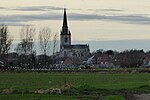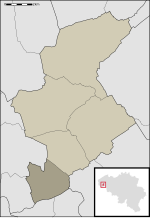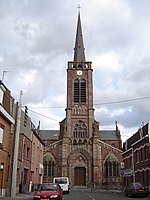Comines-Warneton

Comines-Warneton (French pronunciation: [kɔmin waʁnətɔ̃] (listen); Dutch: Komen-Waasten, Dutch pronunciation: [ˈkoːmə(n) ˈʋɑːstə(n)] (listen); Picard: Comène-Warneuton; West Flemish: Koomn-Woastn; Walloon: Cômene-Varneton) is a city and municipality of Wallonia located in the province of Hainaut, Belgium. On January 1, 2006, it had a total population of 17,562. Its total area is 61.09 km2 (23.59 sq mi) which gives a population density of 287 inhabitants per square kilometre (740/sq mi). The name "Comines" is believed to have a Celtic, or Gaulish, origin. Comines-Warneton is a municipality with language facilities for Dutch-speakers. The municipality consists of the following districts: Bas-Warneton, Comines, Houthem, Ploegsteert, and Warneton (including the hamlet of Gheer). They were all transferred in 1963 from the arrondissement of Ypres in the Dutch-speaking province of West Flanders to the newly created arrondissement of Mouscron in French-speaking Hainaut. The five municipalities (Comines, Houthem, Ploegsteert, Bas-Warneton, Warneton) were merged into a single Comines-Warneton municipality in 1977. Since then, the municipality forms an exclave of both Hainaut and Wallonia, being surrounded by the Flemish province of West Flanders and the French department of Nord and not connected to the rest of the French-speaking area of Belgium. Comines-Warneton is twinned with Hedge End in England and with Argenton-les-Vallées in France.
Excerpt from the Wikipedia article Comines-Warneton (License: CC BY-SA 3.0, Authors, Images).Comines-Warneton
Rue des Arts,
Geographical coordinates (GPS) Address Phone number Website Nearby Places Show on map
Geographical coordinates (GPS)
| Latitude | Longitude |
|---|---|
| N 50.766666666667 ° | E 3 ° |
Address
Centre culturel MJC
Rue des Arts 2
7780
Hainaut, Belgium
Open on Google Maps










